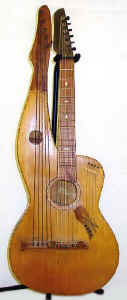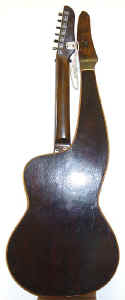
|
Featured Harp Guitar of the Month Another 1-of-a-Kind Knutsen Convertible by Gregg Miner, April, 2006 |
| This is a strange one! One of
Knutsen's more original designs - in a thirty-plus-year career of
constant experimentation. What's most unusual, of course, is the
"backwards" 6-on-a-side Fender-style headstock! This is
a Knutsen first - only one other is known (HW16),
with the headstock in "normal" orientation. Perhaps to
compliment the strange headstock, the sub-bass headstock is also a
completely new design.
But even those familiar with Knutsen's instruments through the Archives may well ask: Is it a harp guitar with five sub-bass strings? Or a harp Hawaiian guitar? |
|
| Like most "convertible" Knutsens, it could theoretically be either. For those new to these clever, if woefully impractical, instruments, here's how they work. A bracket system is used to adjust and set the neck angle, and convert it as desired for either "Spanish" or "Hawaiian" style playing. Taking advantage of the position of the harp arm, Knutsen installed a slotted bracket (with wing-nut) connecting the adjustable fretted neck to the immobile harp arm. The back of the neck is then scooped out where it meets the body, and connects with two "L" brackets, which act as a hinge. Besides the crude brackets, the neck is also permanently connected via the glued fingerboard, which bends at this join also. Yes, the neck will twist, because at the nut, it is only held by the wing nut on the bass side, and, no, it cannot be kept or played in tune! |
| But playing fretted chords appears to have been a secondary option; the evidence shows that these guitars were geared toward Hawaiian players. Not only were many of the originally installed nuts high (for slide playing), but two specimens (HCP12 and HCN1) have only inlaid flush frets - so they can only be played lap style. On those instruments with flush frets, while "convertibility" is still physically possible, itís a useless option, and the bracket system would have just been used for simple neck set and adjustments. |

|
But is this instrument different? Despite appearances, no, not really. By "appearances," I refer to the number of sub-basses, and the outline of the guitar - an outline that at first glance resembles Knutsen's early Symphony harp guitars. It is a rare form that I call a "No Point Harp Hawaiian" (or harp steel guitar) - as the common form, the "Upper Treble Point," has that unique and unmistakable pointed upper bout on the treble-side (see Hawaiian Guitars). The inclusion of five sub-basses does hint at standard harp guitar use, as five seems excessive for a harp steel guitar. Only one other (HCP18) has five also; most other hollow-arm harp-convertibles have either 3 or 4 sub-basses, and occasionally 2, like all of the Weissenborn-shaped harp steels. And the guitar has metal frets, all the way up to the 15th fret, after which inlaid markers take over. |
| But it has an original high, slanted nut, so it was clearly set up to be played lap-style. Like most of these instruments, the nut is held in place by a screw, and my guess is that Knutsen simply provided the purchaser with two nuts, one low, one high - either of which could be quickly changed, held in place by the screw. My other assumption is that the nut these guitars are found with (if original) identify the likely preferred configuration of the customer - it was certainly the last used. |
|
When they are present, four super-trebles are standard on the Weissenborn-shaped harp steels, and also on the majority of the hollow arm harp steel convertibles. Some of the latter come with 5 or 6 trebles occasionally - further blurring the line with true Knutsen harp guitars, which typically have 7 super-trebles (if they have any). The Temple Street label (cut down from his larger one) identifies this as a 1920's Los Angeles Knutsen. |
 |
Back and sides are of an unknown, stained wood.
This is specimen # HCN3 in The Knutsen Archives Inventory. I hope to visit this instrument one day and get further information and better photos - it certainly deserves it. Whether it's an "oddball," a "diamond in the rough," or a cool, "pre-retro" harp guitar, it is pure Knutsen all the way. A very special thanks to the owner - Ed Douglas of The Double Eagle in San Diego - for sharing this rare and important instrument with us! |
|
Harp Guitar of the Month: Archives |
|
Collectors, Authors, Scholars: Want to create a page
about a certain harp guitar maker or instrument? Contact me!
See also: Knutsen Hawaiian Guitars and Chris Knutsen: Harp Guitar "Triple Threat." and, of course, |
|
If you enjoyed this article, or found it
useful for research, please consider making a donation to The
Harp Guitar Foundation, |
|
|
|
All Site Contents Copyright © Gregg Miner,2004-2020. All Rights Reserved. Copyright and Fair Use of material and use of images: See Copyright and Fair Use policy. |